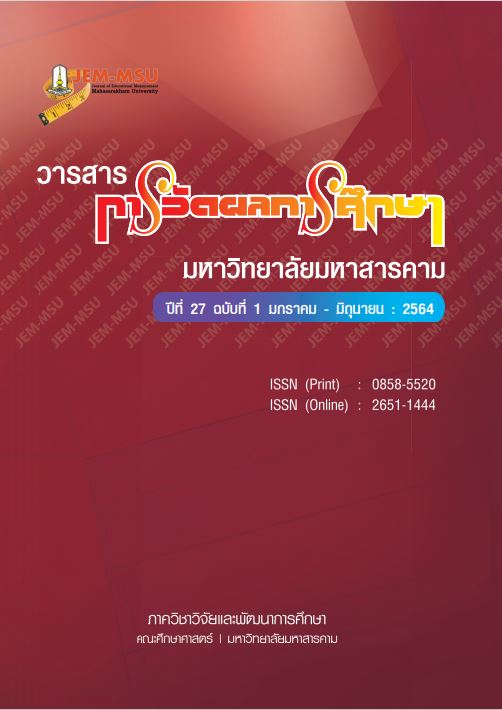A synthesis of Researches on the 21st Century Competency Measurement Tool Development for Secondary School Students
Main Article Content
Abstract
This research aimed to 1) evaluate the quality of researches on the 21st century competency measurement tool development for secondary school students, 2)study characteristics of research affecting the standard indices of the 21st century competency measurement tools for measuring quality of secondary school students, and 3) synthesize the body of knowledge about the development of tools for measuring the 21st century competencies of secondary school students. Ninety-two research papers were synthesized by meta-analysis method. The research instruments were research quality evaluative forms and research characteristics coding forms. The data analysis employed descriptive statistics, one-way ANOVA and content analysis.
The findings were as follows:
1. The result of the research quality evaluation revealed that most theses (82.61%) were of good quality and the rest (17.39 %) were of very good quality.
2. The results of the analysis of research characteristics affecting the quality standardized indices of the 21st century competency measurement tools for the secondary school students indicated that:
2.1 There were 11 research characteristic variables affecting the reliability standardized indices. They were: types of institutions that produce research, institutions that produce research, fields of research, researcher’s gender, regions, levels of the sample, types of measurement tool, number of choices or criteria, scoring, number of items in the subtest and sampling designs.
2.2 The research characteristic variable affecting the validity standardized indices was the related content.
2.3 There were 6 research characteristic variables affecting the difficulty standardized indices: year of publishing, types of research, measurement tool developing, types of measurement tool, number of choices or criteria, and sampling designs.
2.4 There were 10 research characteristic variables affecting the discrimination standardized indices: year of publishing, types of institutions that produce research, institutions that produce research, fields of research, researcher’s gender, regions, levels of the sample, types of measurement tool, number of items in the subtest, and the sample size.
3. The synthesis of the body of knowledge revealed that the steps of measurement tools development in each competency were similar but there were differences in the types and scoring criteria of measuring tools. The tools were classified into 4 groups as follows: 1) rating scale, 2) situation test, 3) multiple-choice test and, 4) subjective test.
Article Details
The content and information contained in the published article in the Journal of Educational Measurement Mahasarakham University represent the opinions and responsibilities of the authors directly. The editorial board of the journal is not necessarily in agreement with or responsible for any of the content.
The articles, data, content, images, etc. that have been published in the Journal of Educational Measurement Mahasarakham University are copyrighted by the journal. If any individual or organization wishes to reproduce or perform any actions involving the entirety or any part of the content, they must obtain written permission from the Journal of Educational Measurement Mahasarakham University.
References
กชพรรณ เภสัชชา. (2560). การสร้างแบบวัดความคิดสร้างสรรค์ทางวิทยาศาสตร์สำหรับนักเรียนระดับชั้นมัธยมศึกษาปีที่ 3. (วิทยานิพนธ์ปริญญามหาบัณฑิต). มหาวิทยาลัยราชภัฏมหาสารคาม, คณะครุศาสตร์, สาขาวิจัยและประเมินผลการศึกษา.
กมลวรรณ ตังธนกานนท์. (2557). การวัดและประเมินทักษะการปฏิบัติ. กรุงเทพฯ: โรงพิมพ์แห่งจุฬาลงกรณ์มหาวิทยาลัย.
ไชยยศ ไพวิทยศิริธรรม. (2544). การวิเคราะห์อภิมานคุณภาพของแบบสอบหลายตัวเลือกที่มีรูปแบบของแบบสอบ บริบทของแบบสอบ และวิธีการตรวจให้คะแนนต่างกัน. (วิทยานิพนธ์ปริญญามหาบัณฑิต). จุฬาลงกรณ์มหาวิทยาลัย, คณะครุศาสตร์, สาขาวิชาการวัดและประเมินผลการศึกษา.
บุญใจ ศรีสถิตย์นรากูร. (2555). การพัฒนาและตรวจสอบคุณภาพเครื่องมือวิจัย: คุณสมบัติการวัดเชิงจิตวิทยา (Development and validation of research instruments: Psychometric properties). กรุงเทพฯ: โรงพิมพ์แห่งจุฬาลงกรณ์มหาวิทยาลัย
บุญเรียง ขจรศิลป์. (2550). ทำวิจัยอย่างไรให้มีคุณภาพ: ความคลาดเคลื่อนในการทำงานวิจัยทางการศึกษา.ในการประชุมสัมมนาทางวิชาการกระบวนการวิจัยกับการพัฒนาทางการศึกษา. กรุงเทพฯ: คณะศึกษาศาสตร์มหาวิทยาลัยเกษตรศาสตร์.
พิชิต ฤทธิ์จรูญ. (2556). หลักการวัดและประเมินผลการศึกษา. พิมพ์ครั้งที่ 8. กรุงเทพฯ: บริษัท เฮ้าส์ ออฟเครอ์มิสท์ จำกัด.
ภัคณัฏฐ์ สมพงษ์ธรรม. (2551). การเปรียบเทียบคุณภาพของแบบวัดความสามารถในการเผชิญและฟันฝ่าอุปสรรคตามทฤษฎีของสโตลซ์ระหว่างมาตรประมาณค่ากับแบบวัดชนิดสถานการณ์ : การประยุกต์ใช้ทฤษฎีการตอบสนองข้อสอบแบบพหุวิภาค. (วิทยานิพนธ์ปริญญามหาบัณฑิต). จุฬาลงกรณ์มหาวิทยาลัย, คณะครุศาสตร์, สาขาวิชาการวัดและประเมินผลการศึกษา.
รัตนะ บัวสนธ์ และคณะ. (2557). การประเมินคุณภาพวิทยานิพนธ์ของนิสิตระดับดุษฏีบัณฑิต มหาวิทยาลัยนเรศวร. วารสารศึกษาศาสตร์ มหาวิทยาลัยนเรศวร, 16(1), 120-126.
วัยญา ยิ้มยวน. (2547). การวิเคราะห์อภิมานของปัจจัยที่มีความสัมพันธ์กับการคิดวิจารณญาณ. (วิทยานิพนธ์ปริญญามหาบัณฑิต). จุฬาลงกรณ์มหาวิทยาลัย, คณะครุศาสตร์, สาขาวิชาวิจัยการศึกษา.
ศศิธร เวียงอินทร์. (2547). การพัฒนาแบบวัดความคิดสร้างสรรค์ทางคณิตศาสตร์ สำหรับนักเรียนชั้นมัธยมศึกษาปีที่ 1 ของโรงเรียนในสังกัด สำนักงานเขตพื้นที่การศึกษาร้อยเอ็ด เขต 1. (วิทยานิพนธ์ปริญญามหาบัณฑิต). มหาวิทยาลัยมหาสารคาม, คณะศึกษาศาสตร์, สาขาวิชาการวัดผลการศึกษา.
ศิริชัย กาญจนวาสี. (2556). ทฤษฎีการทดสอบแบบดั้งเดิม. พิมพ์ครั้งที่ 7. กรุงเทพมหานคร: โรงพิมพ์แห่งจุฬาลงกรณ์มหาวิทยาลัย.
สมศักดิ์ ภู่วิภาดาวรรธน์. (2544). เทคนิคการส่งเสริมความคิดสร้างสรรค์. พิมพ์ครั้งที่ 7. กรุงเทพฯ: ไทยวัฒนาพานิช.
สุชาดา ยอดสุรางค์. (2552). การพัฒนาแบบวัดความคิดสร้างสรรค์ทักษะภาษาอังกฤษของนักเรียนชั้นมัธยมศึกษาปีที่ 1 สังกัดสำนักงานเขตพื้นที่การศึกษาขอนแก่น เขต 1. (วิทยานิพนธ์ปริญญามหาบัณฑิต). มหาวิทยาลัยราชภัฎเลย, คณะครุศาสตร์, สาขาวิจัยและประเมินผลการศึกษา.
สุวิมล เสวกสุริยวงศ์. (2553). การสังเคราะห์งานวิจัยเกี่ยวกับการสร้างแบบสอบวินิจฉัยทางคณิตศาสตร์. (วิทยานิพนธ์ปริญญามหาบัณฑิต). จุฬาลงกรณ์มหาวิทยาลัย, คณะครุศาสตร์, สาขาวิชาการวัดและประเมินผลการศึกษา.
สุวิมล ติรกานันท์. (2551). การสร้างเครื่องมือวัดตัวแปรในการวิจัยทางสังคมศาสตร์: แนวทางสู่การปฏิบัติ. พิมพ์ครั้งที่ 2. กรุงเทพมหานคร: โรงพิมพ์แห่งจุฬาลงกรณ์มหาวิทยาลัย.
สำนักงานเลขาธิการสภาการศึกษา. (2560). แผนการศึกษาแห่งชาติ พ.ศ. 2560-2579. กรุงเทพมหานคร: บริษัท พริกหวานกราฟฟิค จำกัด.
สำนักงานเลขาธิการสภาการศึกษา. (2552). รายงานการสังเคราะห์งานวิจัยเกี่ยวกับคุณภาพการศึกษาไทย: การวิเคราะห์อภิมาน (Meta-analysis). กรุงเทพฯ: โรงพิมพ์แห่งจุฬาลงกรณ์มหาวิทยาลัย.
อาภาพรรณ ประทุมไทย. (2553). การวิเคราะห์อภิมานคุณภาพของแบบวัดความถนัด. (วิทยานิพนธ์ปริญญามหาบัณฑิต). จุฬาลงกรณ์มหาวิทยาลัย, คณะครุศาสตร์, สาขาวิชาการวัดและประเมินผลการศึกษา.
Cheng, K-M. (2017). Advancing 21st century competencies in East Asian education systems. [Online]. Available from: https://asiasociety.org/files/21st-century-competencies-east-asian-education-systems.pdf[2019, Jun 11]
Cheng, K-M., Jackson, L. & Lee, W. (2017). Advancing 21st century competencies in Hong Kong.[Online]. Available from: https://asiasociety.org/files/21st-century-competencies-hong-kong.pdf[2019, Jun 11]
Greenstein, L. (2012). Assessing 21st century skills: A guide to evaluating mastery and authentic learning. Thousand Oaks, CA, US: Corwin Press.
Metiri Group. (2003). enGauge 21stcentury skills for 21st century learners.[Online]. Available from :https://www.cwasd.k12.wi.us/highschl/newsfile1062_1.pdf[2019, Jun 11]
Miller, D., Linn, R & Gronlund, N. (2009). Measurement and Assessment in Teaching. 10th ed. Upper Saddle River, NJ : Pearson
Ministry of Education, Singapore. (2018). 21st century competencies.[Online]. Available from: https://www.moe.gov.sg/education/education-system/21st-century-competencies[2019, Jun 11]
Nitko, A. J. & Brookhart, S. M. (2007). Educational assessment of students. 5th ed. Upper Saddle NJ: Pearson Education.
Partnership for 21st Century Learning. (2019). Framework for 21st century learning definitions.[Online]. Available from: http://static.battelleforkids.org/documents/p21/P21_Framework_DefinitionsBFK.pdf[2019, Jun 11]
Reynolds, C., Livingston, R., and Willson, V. (2009). Measurement and assessment in education. 2nd ed. Boston: Pearson.
World Health Organization. (1997). Life Skills Education for Children and Adolescents in School. Geneva: World Health Organization.


